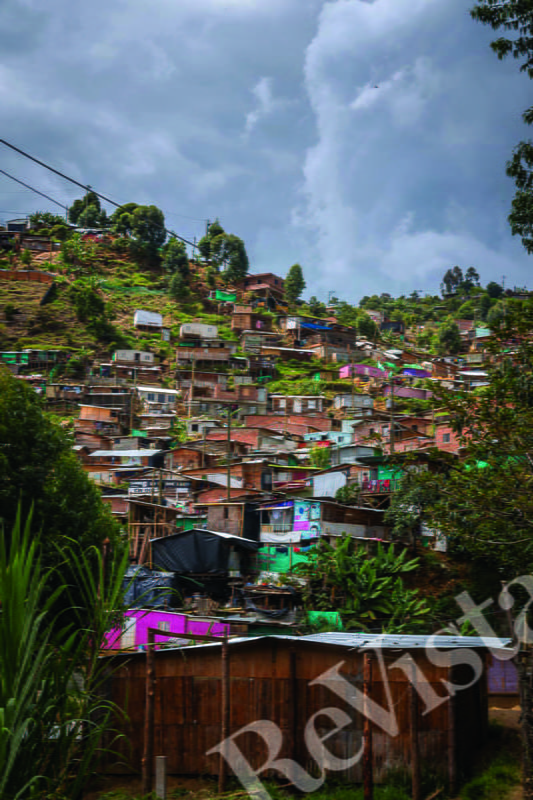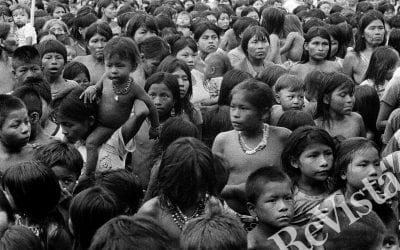La Espina
The two of us, leading an Emerson College international program, had just finished three weeks of round-the-clock work making a short documentary film with community members in Manantiales de Paz—Springs of Peace—a neighborhood founded by displaced persons in Medellín, Colombia. That’s when Claudia called. She was distraught. She had una espina, a thorn, in her heart, she said. Very soon we were to learn why this seemingly small feeling would prompt community leaders to bring our years of work together to a halt. And do so in the name of local and global peace process.
Finishing up a summer session with Emerson College students to make the film, we were ready to present it to community residents and leaders for their final input. These leaders had founded Manantiales de Paz seven years ago, built the first homes and roads and sewage and household water channels with their own hands. They invited us and the students to document their neighborhood. They wanted to show residents and outsiders why and how a group of 14 families, originally displaced by violence from their hometowns across Colombia, founded this neighborhood. And explain what they need now to survive a sprawling urban growth and become an official (legal) part of the urban infrastructure around them. Located near the top ridge of the Andes Mountains between the cities of Medellín and Bello, Manantiales de Paz is now home to more than 3,000 residents.
Manantiales de Paz is an example of a larger condition of displacement in Colombia, a country with more than six million internally displaced people. Internal displacement means they were forced by violence to flee their hometowns, often with nothing more than what they could carry in their arms. For many that means clothes, a few supplies and photos in a satchel on their back and their children in their arms. Manantiales de Paz, where more than 80 percent of its population had been forced from their homes, now has a neighborhood center, a field for soccer and other sports; it also has a church, library, computer lab and community center that doubles as a soup kitchen and classroom.
Claudia’s espina started after a potential donor spontaneously gave her a personal amount of cash. She was being accused of embezzlement and was calling us to help restore her good standing with the community. That past week, we had brought two prospective donors to the community kitchen, a brick room inside a maze of narrow mud-floor corridors where Claudia and other community leaders are struggling to feed children and elders. Community members explained to the donors their role in founding this informal settlement and how they continue living there after more than six successive evictions by police and local government agencies. They told the donors that the “paz” [peace] in the name of the settlement is meant to send a message: while violence forced them to begin building homes there as “squatters,” they are not at war, and even though in the beginning government forces razed their homes several times, they had nowhere else to go and so continued to rebuild there, and in the process, to raise white flags in peace.
Claudia wanted the two of us to explain to the rest of the community the context in which she had acquired funds to fix her house. While we were in shock being in this uncomfortable position of somehow contributing to a situation in which a community member would be inaccurately accused of embezzlement, we understood very clearly what was happening here. We, for years have been training our students on how to deal with the issue of donations to our community members, to make sure they do not create frictions between them. Our potential donor in his visit through the settlement had become emotionally attached to Claudia, a mother of three who lives in a flimsy shack in which torrential rains routinely cause her walls and roof to collapse. Claudia, years earlier, had led a group of women to found and maintain another building, the community kitchen (non-funded at the time). She had secured a new space and was looking for resources to make the kitchen work again, meaning funding for food. Our potential donor had suddenly opened his wallet during our tour and asked Tamera, whom everyone knows as Tam, to translate for him; he wanted to give her that money to support her personal housing so she could continue her community work. This caused much gossip and accusations of embezzlement—and also for some community members who did not know us well to look at us, as film directors, urban planners and story tellers, with distrust.
So Claudia called for a community leader meeting to clear the air. The thorn had taken root in her heart and that of other community leaders. As Don Antonio, the community-elected president of the Neighborhood Association and founding member of Manantiales de Paz, later put it: “We have to remove this espina and do so lovingly. Otherwise, the thorns will take over our garden. Thorns will replace the flowers, that is nuestra paz we have worked so hard to build over the last seven years.”
THE MEETING
At daybreak on Monday, we began our journey up the mountain from Medellín to Manantiales de Paz: 40 minutes in two metro lines, then a metrocable (like an enclosed ski lift structure) a few thousand feet up the Andes and then a 40-minute walk through other neighborhoods that had begun as informal settlements decades before, until we reach the end of the paved roads and thus the city limits and walk in mud to then climb a set of slippery steps the community members had built the height of a ten-story building. We arrived at Manantiales’ official neighborhood public space, the central plaza. We walked through the labyrinth that leads to the comedor and found two other community members with Claudia, her eyes swollen and very red. It took more than two hours for all to arrive. The room was very tense. However, with each member who arrived, there were hugs, kisses and small talk. Don Antonio, a tall robust black man from Chocó on the Pacific coast, entered with a beautiful smile. He took his time saying hello to each of us, and then finally, sat at the table. He looked at the cookies we had brought, a small food item we always contributed to each of our meetings. Don Antonio ate one of them and made a facial expression as if they were made of heaven. The chatter became more intense as more people arrived. Finally, we began.
Silence filled the room. Claudia again in tears explained her case, mainly the story of how she received the donation and that she was very sorry. Each person gave his or her point of view regarding the donation and its subsequent use, and so did we. The somber mood began to give way—rapidly—as other members felt happy they were heard by everyone involved. We then moved to discussing how to resolve the conflict. They agreed that if someone gives one of them money for his or her own use, that this is acceptable and ethical. In the end, they expressed they were happy that Claudia had money to use for her house and that we had brought someone who would have donated something to a member of the community.
But other espinas remained. Another community leader, Ena, from Urabá, the banana growing region of Colombia, had worked with Claudia in the community kitchen. She runs a restaurant on the porch just outside her wood shack house, which is where the donor’s gift took place. Ena could not attend our first meeting because of a doctor’s appointment. So the community leaders agreed we needed to meet again a group to listen to Ena and then to collectively decide on a policy for money given by donors.
THE SECOND MEETING
We made the same 90-minute journey up the mountain to Manantiales de Paz early in the morning for the second meeting. The mood in the community kitchen, where the meeting was held, seemed tense. Small talk. Tearful red eyes among some. We waited. And waited.
Our students, heavy with camera equipment and suspense were waiting outside in the plaza, kicking around a soccer ball with the children or sitting and waiting. Only the elders were allowed at this meeting. We were given word that the last founding community leader was still in the shower. So Tam asked if anyone knew any songs and would like to sing to pass the time. Were there any songs that made them happy? Songs of peace? Songs of pain? The room erupted in song. The group all began to clap and sing and stomp feet and laugh. A few women began shaking their hips in dance. The last community member arrived through the narrow door and burst into full-bellied serenade. He had dressed very carefully for this meeting, from newly dyed hair to shined black shoes. He sang four songs and when everyone had eaten a cookie and was smiling (though a few still had red eyes), Don Antonio opened the meeting.
This time, we listened to Ena discuss her espina. She sobbed about children not having enough to eat and how that broke her heart. She cried as she said she just was confused about how the money Claudia received on her porch was being used. She thought it should have gone to the children’s food and not Claudia’s house. She agreed a private donation should be used for private use. But she was reluctant to believe that that particular donation was to be used as such. Everyone around the room spoke again about their interpretation of the funds. Once agreement about the funds was reached, another set of grievances emerged between the two women. This time it was about the fact that one had spoken badly about the other and the hurt feelings and distrust this had borne. The community leaders listened intently. Once the storm of words and tears between the two women began to subside, Don Antonio leaned forward, repeated slowly the policy regarding private donations that they had collectively decided. “Do I understand this correctly?” he asked. All nodded slowly, si señor, yes. Then he proposed a metaphor. He held up one hand and asked us, “How can one hand possibly clap?” Then he put his two hands gently together, almost as if in prayer, and began to slowly clap and said: “Together, we can bring happiness to the other. We have to join our hands. We have to be united in our community. If distrust comes between us, the community founders and leaders, if we as elders in our community do not model peace, our peace will be broken. We will break.”
Tam then asked them, to close the meeting by telling the story about how they put up white flags outside their first ranchitos, make-shift shacks of wood pieces and plastic to show the government, police and military they were there in peace and to please not destroy their homes. Jota, one of the other project co-directors, had provided a few dollars in advance of the meeting for sheets of white paper. Each member at the table, including us as film directors, made white flags and wrote messages of love and peace on them.
Tam asked if they would like us to suspend filming until the process was finished. They all discussed it a moment and decided that no, we should continue our film project. So, under the glaring tropical afternoon sun, hours since we entered the building under the cool blanket of fog, we told the waiting students they could resume their work. They began by coming into the community kitchen and filming us making white flags.
WHAT DOES LA ESPINA AS A PEACE PROCESS TEACH US?
This story of negotiating a misunderstanding among community members was a privileged opportunity to learn firsthand the way this group of men and women engage in conflict among themselves. They trusted us, outsiders and with cameras, to witness and deeply engage in the intimate and private leadership process of maintaining peace under sometimes abject poverty and relentlessly consistent marginalized living conditions. Storms collapse their roofs, send rivers of contaminated sludge flowing through their homes, making the steep climb in and out of their neighborhood a toxic and dangerous drama of slipping and sliding through the wet earth. To maintain peace, they collectively repair each other’s homes from storm-induced landslides as seriously as they collectively remove an emotional espina and the ensuing misunderstandings and gossip. This negotiation helped us, as filmmakers and urban planners, to understand how Manantiales de Paz, as a group of people and as a neighborhood, has been able to survive in the context of three critical conditions that are negotiated by residents in informal communities throughout Colombia and the world.
(1) Displacement and informal settlements. Desplazados are forced to find housing through informal channels which puts them again at high risk. Displaced by war, these population groups seek to rebuild their lives in places that do not suffer armed conflict. They usually try to move where they have local connections or potential for employment. Major cities often offer these social networks and employment. The large population of displaced people present problems for cities with increasingly scarce urban resources, thus creating tension between community settlement residents and government actors and the general population in the formal city. This tension tends to increase as the population of the informal settlement increases.
(2) The challenges of self-governance. Founding an informal settlement is an exercise of collective action to acquire land and subsequent self-governance. Communities that succeed in this collective action are defenseless and resourceless from the official state. Yet, the desplazados‘ organizational capacity is fundamental to stand against state and private actors who have legal rights over the territories that these communities occupy. This capacity is further challenged as their population grows, its needs diversify and problem-solving decisions become harder to make and enact…
(3) Living amidst violence. One emerging actor now challenging the supremacy of the founding governance group are armed groups, first in the form of local gangs and later organized crime franchises. Thus, the larger danger for these communities comes from within. Gangs, a product of the diversification of organizations, present the greatest challenges for the development of these communities. In the absence of an effective state, which in most cases opposes the desplazados‘ claim on the land, even razing their homes to the ground over and over again, community members must find their own ways to negotiate and deal with these armed actors that challenge the rule of the state.
Manantiales de Paz is dealing with all of these conditions. This espina story, as simple as it sounds, taught us many profound things about the hope and resilience of this community not just as an idea, but as a sophisticated strategic process that navigates peace across diverse geographical, cultural, racial and gendered identities among community residents. Doing all this through tears, singing, stories, hugs and even systemic hunger is a kind of miracle. But it is a strategic skilled miracle that community leaders in Manantiales de Paz repeat every day and have done so for the last seven years.
In a context of a national effort for a peace agreement that would open a window to the end of the suffering of millions of displaced populations in Colombia, this particular moment taught us that those who have lost the most and continue to suffer the most can teach us the most on how Colombia can achieve and sustain peace.
This was the first time that we had been working in the same community with the same leaders for three years in a row and thus understood more deeply the problems caused by our very presence, even (or especially) when contributing through donations of money, time and film, to the self-defined needs of the community. This was the deepest trust we had experienced between us and the community members. We realized that it is not only our final product (film, urban plan, a community center, a grant proposal) that is an alternative peace-making force. Our process must also be an alternative peace-making force. Because by telling the story we become part of the story and its outcome. Only now that we have learned about thorns (espinas) and how the leaders in Manantiales de Paz remove them, is it possible to truly revise this film into a story the community leaders will identify as what they desire and need. Only now can we as filmmakers and urban planners more deeply understand the nuances of everyday peace process enough to attempt a narrative bridge between here and there, that is from Manantiales de Paz to local and outside audiences.
Jota Samper, Ph.D. is an Assistant Professor in the Program in Environmental Design, University of Colorado Boulder.
Tamera Marko, Ph.D. is a Senior Lecturer in the Department of Writing, Literature & Publishing, Emerson College and Director of the Emerson College International Program Global Pathways Colombia. Together with communications designer and documentary film maker Ryan Catalani, they founded and co-direct a nonprofit that collaborates with artists, researchers, educators and community members throughout the Americas to document and circulate solutions to environmental and humanitarian crises. The documentary video, academic articles and photographs about Manantiales de Paz can be found on their website: http://www.mobilitymovilidad.org
Related Articles
Displacements: Editor’s Letter
The sweet pure tones of a violin emanated through my grade school auditorium. Ten-year- old Florika, a refugee after the 1956 Hungarian Revolution, was turning the warmth of once- living wood into a powerful source of communication. Florika spoke no English…
36 Hours (and More) in Cartagena
I arrived in Colombia in August 2014 on a Fulbright grant to research La Liga de Mujeres Desplazadas (The League of Displaced Women), an organization formed in the late 90s in…
Voices from the Atrato River
A traditional panga boat with thirty passengers cruises the mighty waters of the Atrato River in the Pacific region of Colombia, doing a 142-mile route from Quibdó to…





